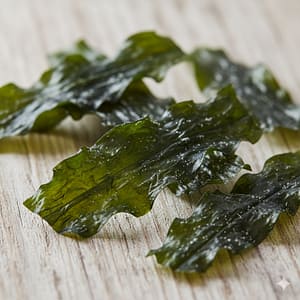- Home
- Wakame Seaweed (Undaria pinnatifida)

I. General Information
A. Scientific Name:
Undaria pinnatifida
B. Alternative Names:
Sea Mustard
C. Pronunciation:
wah-kah-meh
II. Sourcing and Origin
A. Source:
Cultivated in East Asia, especially Japan and Korea; wild populations found in cold-temperate seas.
B. Geographic Origin:
Japan, Korea, temperate Pacific
C. Method of Processing:
Blanched, salted, or dried
III. Properties and Uses
A. Physical Properties:
Thin fronds, dark green to brown, silky texture
B. Chemical Composition:
Fucoxanthin, omega-3 fatty acids, iodine, calcium, vitamins A, C, K
C. Primary Uses:
Skincare: Anti-aging and antioxidant extracts
Haircare: Shine-enhancing mineral content
Wellness: Supports metabolism and bone health
Culinary: Miso soup, salads, stir-fries
Household: Adds nutrients to broth
D. Key Benefits:
Boosts metabolism, supports weight management, bone health
IV. Safety and Considerations
A. Potential Allergies:
Iodine reactions possible
B. Best Practices for Use:
Soak dried wakame in water briefly before use
C. Special Precautions:
Excess consumption may impact thyroid due to iodine
V. Fun & Educational Facts
A. Historical Context:
Used in Japanese and Korean cuisine for centuries; introduced to Western diets recently
B. Did You Know?
Wakame is considered one of Japan’s “longevity foods”
C. DIY Recipe Idea:
Miso soup with wakame
Wakame cucumber salad
Wakame tofu stir-fry
